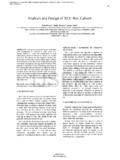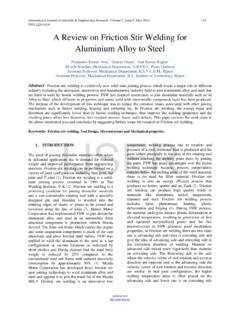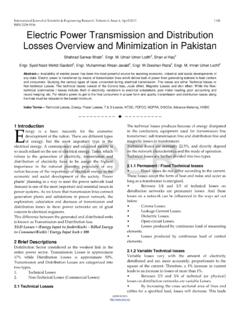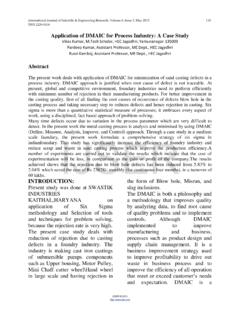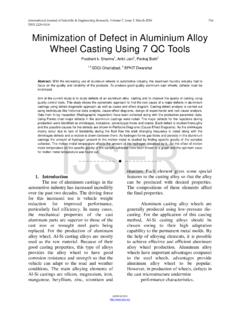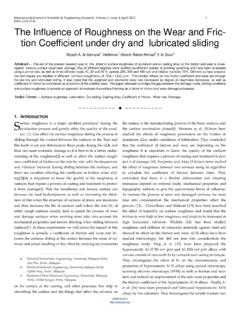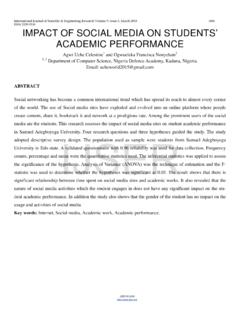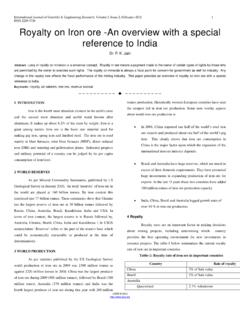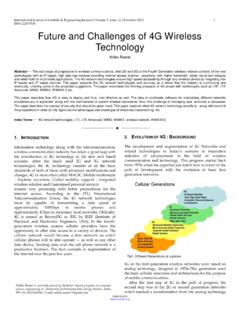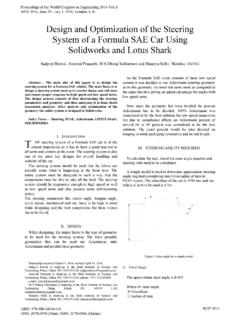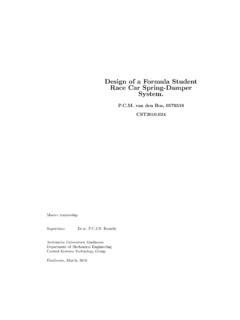Transcription of DESIGN AND ANALYSIS OF SUSPENSION SYSTEM FOR AN …
1 International Journal of Scientific & Engineering Research, Volume 7, Issue 3, March-2016 164 ISSN 2229-5518 IJSER 2016 DESIGN AND ANALYSIS OF SUSPENSION SYSTEM FOR AN ALL TERRAIN VEHICLE Shijil P, Albin Vargheese, Aswin Devasia, Christin Joseph, Josin Jacob Abstract In this paper our work was to study the static and dynamic parameter of the SUSPENSION SYSTEM of an ATV by determining and analyzing the dynamics of the vehicle when driving on an off road racetrack. Though, there are many parameters which affect the performance of the ATV, the scope of this paper work is limited to optimization, determination, DESIGN and ANALYSIS of SUSPENSION systems and to integrate them into whole vehicle systems for best results.
2 The goals were to identify and optimize the parameters affecting the dynamic performance SUSPENSION systems within limitations of time, equipment and data from manufacturer. In this paper we will also come across the following aspects a. Study the static and dynamic parameters of the chassis. b. Workout the parameters by ANALYSIS , DESIGN , and optimization of SUSPENSION SYSTEM . c. Study of existing SUSPENSION systems and parameters affecting its performance. d. Determination of DESIGN parameters for SUSPENSION SYSTEM . Index terms All terrain vehicle, SUSPENSION , caster angle, camber angle, toe angle, roll centre An All-Terrain Vehicle (ATV) is defined by the American National Standards Institute (ANSI) as a vehicle that travels on low pressure tires, with a seat that is straddled by the operator, along with handlebars for steering control.
3 In some vehicles steering wheel similar to passenger cars is also used. As the name suggests, it is designed to negotiate a wider variety of terrain than most other vehicles. Although it is a street-legal vehicle in some countries, it is not legal within most states and provinces of Australia, the United States and Canada and definitely not in India. By the current ANSI definition, it is intended for use by a single operator, although a change to include 2-seaters is under consideration. The All Terrain Vehicle (ATV) was initially developed in the 1960 s as a farmtown vehicle in isolated, mountainous areas. During spring thaws and rainy seasons, steep IJSERI nternational Journal of Scientific & Engineering Research, Volume 7, Issue 3, March-2016 165 ISSN 2229-5518 IJSER 2016 mountainous roads were often impassable with conventional vehicles.
4 It soon became a recreational vehicle however, providing transportation to areas inaccessible by other motorized transport. Royal Enfield CO built and put on sale a powered Quadra cycle in 1893 that worked in the same way as, and resembles, a modern quad-bike. ATVs were made in the United States a decade before 3- and 4-wheeled vehicles were introduced by Honda and other Japanese companies. During the 1960s, numerous manufacturers offered similar small off-road vehicles that were designed to float and were capable of traversing swamps, ponds and streams, as well as dry land. The early ATV s were mainly used for agricultural purpose only. But now the definition of ATV is changing.
5 Many countries are allowing ATVs as commercial vehicle, though with the regulations on its use and safety. Now days, ATVs are generally used in defense and sports application redefining the ATV. Now the ATVs are also coming with durable roll cages, added safety of seat and shoulder belts and higher ground clearance making it more rugged vehicle. The rear cargo deck is more useful for hauling camping gear, bales of hay, tools and supplies making it suitable for exploring back country, riding sand dunes, hunting, fishing and camping. ATVs Sport models are built with performance, rather than utility, in mind. To be successful at fast trail riding, an ATV must have light weight, high power, good SUSPENSION and a low center of gravity.
6 These machines can be modified for such racing disciplines as motocross, woods racing, desert racing, hill climbing, ice racing, speedway, tourist trophy, flat track, drag racing and others. Application of ATV s Initially the ATVs were solely used for the transportation through the inaccessible areas, but now these vehicles have found their application in different areas as mentioned below: a. In Defense Services like army and air force etc to carry and transport guns, ammunition and other supplies to remote areas of rough and varied terrain. b. By railways during construction of railway tracks on mountain or on other rough terrain. c. By police force. d. In sport also like golf for traveling one place to other place. e. In Antarctic bases for research things where use of conventional vehicle is impossible.
7 F. Now a days ATVs are also used in adventuring like mountaineering, in dirt and in snow. Objective The objective of our paper work was to study the static and dynamic parameter of the SUSPENSION SYSTEM of an ATV by determining and analyzing the dynamics of the vehicle when driving on an off road racetrack. Though, there are many parameters which affect the performance of the ATV, the scope of this paper work is limited to optimization, determination, DESIGN and ANALYSIS IJSERI nternational Journal of Scientific & Engineering Research, Volume 7, Issue 3, March-2016 166 ISSN 2229-5518 IJSER 2016 of SUSPENSION systems and to integrate them into whole vehicle systems for best results.
8 The goals were to identify and optimize the parameters affecting the dynamic performance SUSPENSION systems within limitations of time, equipment and data from manufacturer. The objective of the paper includes: e. Study the static and dynamic parameters of the chassis. f. Workout the parameters by ANALYSIS , DESIGN ,and optimization of SUSPENSION SYSTEM . g. Study of existing SUSPENSION systems and parameters affecting its performance. h. Determination of DESIGN parameters for SUSPENSION SYSTEM . 2. SUSPENSION SYSTEM The SUSPENSION of vehicles needs to satisfy a number of requirements which depend on different operating conditions of the vehicle (loaded/unloaded, acceleration/braking, level/uneven road, straight running/ cornering).
9 SUSPENSION systems serve a dual purpose contributing to the vehicle's handling and braking for good active safety and driving pleasure, and keeping vehicle occupants comfortable and reasonably well isolated from road noise, bumps, and vibrations. The SUSPENSION also protects the vehicle itself and mounted systems from damage and wear. SUSPENSION is the term given to the SYSTEM comprise of springs, shock absorbers and linkages that connects a vehicle to its wheels. The DESIGN of front and rear SUSPENSION of a vehicle may be different. Basic Consideration for SUSPENSION SYSTEM Vertical loading When the road wheel comes across the bump or a pit on the road it is subjected to vertical forces (tensile or compressive) depending on the load irregularity which are absorbed by the elastic compression, shear, bending, twisting properties of spring.
10 To reduce the pitching tendency of the vehicle, the front SYSTEM should be less springing than the rear SUSPENSION SYSTEM . Rolling The center of gravity ( ) of the vehicle is considerably above the ground. As a result while taking turns the centrifugal force acts outwards on the of vehicle, while the load resistance acts inwards at the wheels. This give rise to a couple turning the vehicle about the longitudinal axis called rolling. Brake dip and squat On applying brakes the nose of the vehicle dips which depends on the position of relative to the ground, wheel base and other SUSPENSION characteristics. This phenomenon is called as dip. In the same way the torque loads IJSERI nternational Journal of Scientific & Engineering Research, Volume 7, Issue 3, March-2016 167 ISSN 2229-5518 IJSER 2016 during acceleration tend to lift the front of vehicle.
